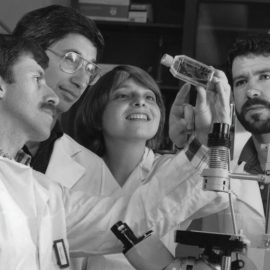
How does technology improve the environment? Can we produce food using fewer resources?
Peter H. Diamandis and Steven Kotler argue that exponential technologies are paving the way toward a future where we can save the environment. Specifically, we can be less wasteful in the ways we produce and consume food.
Find out how technology can protect the environment and reduce harmful waste.
Producing More Food and Saving the Environment
How does technology improve the environment? Technological advances are pioneering better ways to feed a growing global population while also reducing damage to the environment. Specifically, exponential technologies are countering two major issues tied to conventional methods of food production and consumption: waste and the inefficient use of resources.
(Shortform note: According to a UN report, the world population is projected to grow to 9.8 billion by 2050. Some experts argue that we don’t need to produce more food to feed this growing population because globally, we already produce more than enough food to feed the entire planet. Part of the problem lies with extensive global food waste as the authors mention. However, another issue is the lack of biodiversity in agriculture: Over half of the world’s consumed calories come from only four crops (rice, wheat, corn, and soy). This results in homogenous diets that lead to nutritional deficiencies and persisting poverty.)
Reducing Wasteful Production and Consumption
Diamandis and Kotler note that traditional agriculture methods lead to waste in both production and consumption. In the United States, only 60% of the food that’s produced is actually eaten—the rest is either left unharvested or is thrown out by consumers. Yet, despite the fact that the country produces vastly more food than it consumes, many people struggle with food insecurity.
The authors discuss two innovations aimed at reducing waste:
1. Improving photosynthesis. Researchers are exploring ways to increase crop yields by enhancing photosynthesis—the biological process carried out by plants that allows them to turn light energy (usually from the sun) into chemical energy in the form of glucose. Currently, all foods we eat depend on this process—we eat either plants or animals that eat plants. The problem is that photosynthesis isn’t efficient: Less than 1% of sunlight that reaches earth is photosynthesized. To confront this, some researchers have figured out how to genetically modify plants to have higher levels of a protein that aids in photosynthesis, allowing plants to harness more of the available solar energy and produce larger harvests.
2. Developing artificial cutin. Fruits and vegetables produce a material in their peel called cutin that protects them from spoiling. Scientists have manufactured an artificial cutin that’s organic and can coat food to provide an extra layer of protection, preserving the freshness of foods longer. This helps prevent food from going bad before we can eat it, reducing waste.
Efficient Use of Natural Resources
Diamandis and Kotler write that our methods for producing food are highly resource-intensive. Half of the world’s habitable land is used for agriculture, and meat production accounts for 70% global water use. Additionally, most foods must be transported great distances from farm to grocery store, which requires a significant expenditure of time and energy.
(Shortform note: Despite occupying 77% of all farmland, livestock production only accounts for 18% of the world’s calories, highlighting another inefficiency in our global use of resources. The reshaping of natural landscapes into farmland has also drastically changed the global map, leading to the loss of forests, shrubbery, and a variety of habitats. This has taken a significant toll on biodiversity: Out of 28,000 species at risk of extinction, 24,000 have been endangered by agriculture to some extent.)
However, Diamandis and Kotler write that there are two technological innovations poised to reduce the land and water needed to produce food:
1. Cultured meats. Scientists are researching how to grow meat (a steak, for instance) from stem cells to reduce our reliance on the inefficient process of raising and slaughtering animals. The authors note that this process uses far fewer resources like water and land, making it sustainable and affordable as well as more humane.
(Shortform note: In 2023, two startups (Upside Foods and Good Meat) received USDA approval to sell cell-cultivated chicken. These lab-grown meats start off as stem cells extracted from a chicken egg. Food scientists select the best stem cells and freeze them for later use. When it’s time to make the chicken, the cells are placed in a vat filled with a blend of key nutrients that allow them to grow into meat. Scientists then give the meat texture by mixing, heating or shearing it into a nugget or cutlet shape.)
2. Vertical farming. In this approach, crops are grown inside a skyscraper, where conditions such as light and temperature can be controlled. Vertical farming requires less land and water, and it isn’t affected by the weather. Additionally, because vertical farming allows crops to be grown close to city centers, it also reduces the transportation necessary to get products to consumers, thereby reducing energy use.
(Shortform note: Vertical farming has some challenges to overcome before it can overtake traditional forms of agriculture. It’s currently most suited for growing leafy greens such as lettuce. Traditional farming methods are still better for growing cereal, row crops like corn and rice, and small fruits and vegetables (although research on growing these latter foods in vertical farms is ongoing). In addition, while vertical farms hold great promise in reducing energy use, their energy consumption remains relatively high because they require extensive artificial lighting and HVAC systems to control humidity.)






